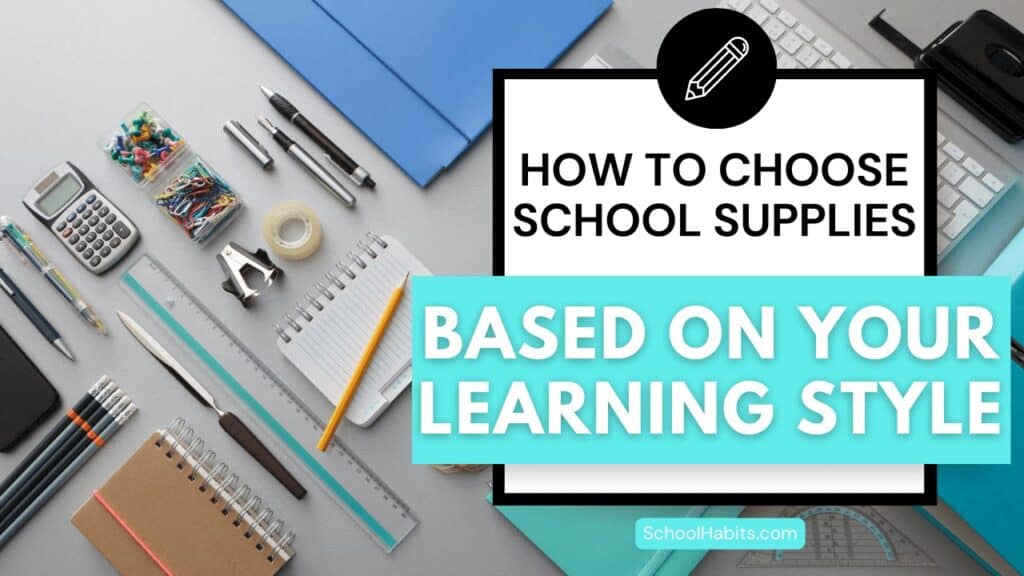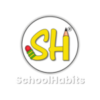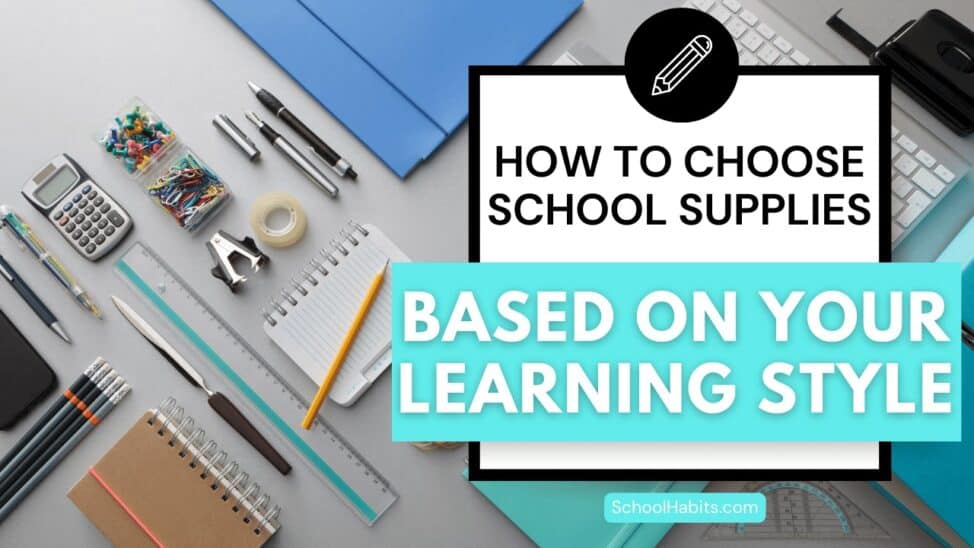By Katie Azevedo, M.Ed.

Learning styles (or learning preferences) can influence the way we feel about and understand what we’re learning. I have many resources that teach tips for setting up your study space and using study methods based on your learning style. You can find those resources at the bottom of this post.
In this blog post, I’m teaching you how to choose school supplies based on your learning style. These are suggestions based on the characteristics of each type of learner, but feel free to add your own preferences and flair to the mix.
The learning styles
The primary learning styles (preferences) are visual, kinesthetic, auditory, and read-write. Most people display characteristics of multiple learner types. Students who can adapt to multiple learning methods often have the most success in school, because their understanding of material isn’t dependent on it being taught in a singular way.
Choosing school supplies based on your learning style
Choosing school supplies should always be personal. Use the following information as a guideline, but it’s important to factor in your past experience with what school supplies have worked or haven’t worked for you.
The best school supplies for visual learners
Visual learners process and remember information better when the material is presented visually instead of orally. Therefore, the best school supplies for visual learners should maximize how you incorporate visuals into your learning.
1. Highlighters
Visual learners benefit from taking notes, regardless of whether note-taking is required. Using highlighters as a way to emphasize headings and subheadings in notes can significantly help information stand out visually on the page. Highlighters are also essential for my Highlight and Rewrite Strategy, which is my number one annotation strategy I suggest for all types of learners,
2. Colored pens
Many visual learners benefit from using color in their notes and annotations. Try using a certain color for certain concepts, such as green for vocabulary words, and blue for main ideas, for example.
3. Notebooks
I suggest getting larger notebooks (8.5 x 11) instead of the half-letter size. Larger notebooks will accommodate visuals, graphs, and other details you add to your notes. I also suggest you get high-quality notebooks with thicker paper. Visual learners are often bothered by bleedthrough because it’s distracting: thicker paper helps prevent bleedthrough.
4. Sticky notes
Sticky notes are the ultimate multipurpose school supply for visual learners. Use these for annotations in books you can’t write in, or to add details to notes in your notebook. Consider investing in sticky note colors that inspire you, and not necessarily the neon ones that are available everywhere – unless you like those ones!
5. Erasable pens
Visual learners can be bothered by messy notes, and visible pens offer a simple solution. Erasable pens have come a long way over the years, and there are lots to choose from.
The best school supplies for auditory learners
Auditory learners better process and understand material when it’s presented verbally, such as in a lecture class, oral explanation, audiobook, or video. The best school supplies for auditory learners support you as you capture information that you hear.
1. Highlighters
Auditory learners should be taking notes based on what they hear in class. Highlighters are excellent for using my annotation Highlight and Rewrite Strategy and for adding emphasis to notes you’re taking in class.
2. Tablet with a stylus
I almost always recommend that students take hand-written notes, but writing notes on an iPad or tablet with a stylus counts as hand-written notes. Auditory learners need to take notes quickly, and digital notes can be quicker for some students.
3. Timers
Auditory learners can benefit from using timers during their study sessions. Because solo study sessions don’t often incorporate auditory elements, auditory learners may struggle to stay focused and motivated when they’re thinking, reading, and writing (without auditory input). Using timers is a great way to incorporate the Pomodoro technique, which can help auditory learners stay focused for short, timed intervals. I like this one.
4. Headphones
If you’re an auditory learner, get yourself a quality pair of headphones. Any time you can add a listening component to what you’re learning, do so. This means listening to the audiobook as you read along in the physical book or listening to video explanations of something that you read in your textbook.
The best school supplies for kinesthetic learners
Kinesthetic learners process and understand material when they can engage with it and do something with it. An example of a kinesthetic learning experience would be doing a lab instead of reading about the experiment.
Many kinesthetic learners also have ADHD. Here’s my list of school supplies and tips I recommend for students with ADHD.
1. High-quality pens
Physical touch is important for kinesthetic learners, so choose high-quality pens that offer a smooth writing experience. If taking notes is more pleasurable because of your pen, you’ll be more likely to do it.
2. Spiral notebooks
Get high-quality spiral notebooks for taking notes. Spiral notebooks are easy to flip over and are good for left-handed and right-handed kinesthetic learners. In my experience with my own students, many of my kinesthetic learners get bored with their school supplies, so consider the reality that you might need to get new notebooks each semester just to add novelty and interest.
3. Three-ring binders
Many kinesthetic learners are successful with three-ring binders instead of separate folders and notebooks for each class. That means that you would put your high-quality notebooks (see above) inside your binder. Here are my best tips for organizing your school binder.
4. Timers
Kinesthetic learners can lose motivation easily and quickly during long study sessions. Using a timer like a timer cube can help kinesthetic learners plan short study sessions using the Pomodoro Technique (or a variation of it).
5. Index cards
One of the best school supplies for kinesthetic learners are index cards. Index cards are multi-functional, and are excellent study tools for using active recall. Because kinesthetic learners benefit from physically manipulating material, index cards provide the opportunity to shuffle, rearrange, and otherwise organize concepts on a large surface. This can be magic.
The best school supplies for read-write learners
Read-write letters better process and understand information when they read and write about it. Therefore, the best school supplies for read-write learners support solid reading, note-taking and annotation strategies.
1. High-quality notebooks
Read-write learners should invest in high-quality notebooks with thick paper that blocks bleed-through. This is not the time to get the $.25 deal at the dollar store for a notebook that’s made of tissue paper. There’s definitely a time for that, but not when it comes to your learning.
2. Smooth pens
The writing experience matters to read-write learners, which means you want tools that give you the best experience possible. No need to purchase really expensive pens, but get good ones that write smoothly and bring you joy. You may need to experiment.
3. Highlighters
Highlighters are essential for using my Highlight and Rewrite annotation strategy. The Highlight and Rewrite Strategy works wonderfully for read-write learners because it incorporates reading and writing together. It’s also possible to get a highlighter that has a highlighter on one end, and a pen on another, like this one.
4. Your own copy of books
I know it’s not always possible, but if it is, read-write learners should get their own copies of novels they’re reading for school. (I know books are expensive and that stinks.) But if you can find a second-hand copy of the book you’re reading for class, you’ll be able to write all over it, which can be really helpful for your learning style.
Final notes about choosing school supplies according to your learning style
Whether you believe in the idea of learning styles or not, prefer to call them learning preferences, or have never heard of them before, choosing the right school supplies to support your unique way of learning is essential. Quality school supplies can be an investment, but there’s nothing more valuable to invest in than your own education. Super cheesy, but super true.
Other resources about learning styles
The ultimate learning style guide: Use this to get started understanding how learning styles work, as well as the characteristics of each.

